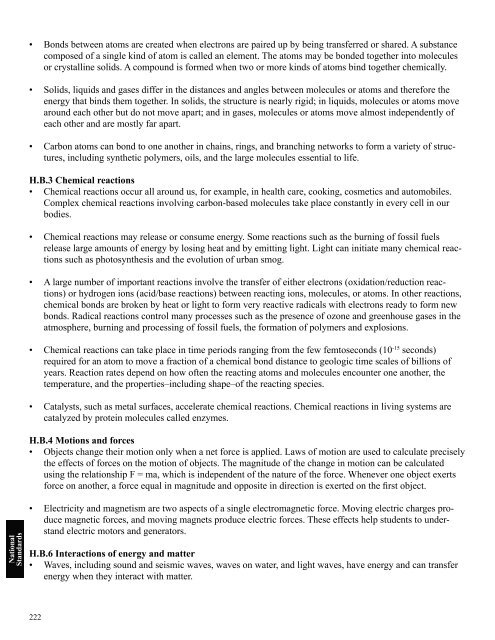ScienceMakers Toolkit Manual - The History Makers
ScienceMakers Toolkit Manual - The History Makers
ScienceMakers Toolkit Manual - The History Makers
You also want an ePaper? Increase the reach of your titles
YUMPU automatically turns print PDFs into web optimized ePapers that Google loves.
National<br />
Standards<br />
• Bonds between atoms are created when electrons are paired up by being transferred or shared. A substance<br />
composed of a single kind of atom is called an element. <strong>The</strong> atoms may be bonded together into molecules<br />
or crystalline solids. A compound is formed when two or more kinds of atoms bind together chemically.<br />
• Solids, liquids and gases differ in the distances and angles between molecules or atoms and therefore the<br />
energy that binds them together. In solids, the structure is nearly rigid; in liquids, molecules or atoms move<br />
around each other but do not move apart; and in gases, molecules or atoms move almost independently of<br />
each other and are mostly far apart.<br />
• Carbon atoms can bond to one another in chains, rings, and branching networks to form a variety of structures,<br />
including synthetic polymers, oils, and the large molecules essential to life.<br />
H.B.3 Chemical reactions<br />
• Chemical reactions occur all around us, for example, in health care, cooking, cosmetics and automobiles.<br />
Complex chemical reactions involving carbon-based molecules take place constantly in every cell in our<br />
bodies.<br />
• Chemical reactions may release or consume energy. Some reactions such as the burning of fossil fuels<br />
release large amounts of energy by losing heat and by emitting light. Light can initiate many chemical reactions<br />
such as photosynthesis and the evolution of urban smog.<br />
• A large number of important reactions involve the transfer of either electrons (oxidation/reduction reactions)<br />
or hydrogen ions (acid/base reactions) between reacting ions, molecules, or atoms. In other reactions,<br />
chemical bonds are broken by heat or light to form very reactive radicals with electrons ready to form new<br />
bonds. Radical reactions control many processes such as the presence of ozone and greenhouse gases in the<br />
atmosphere, burning and processing of fossil fuels, the formation of polymers and explosions.<br />
• Chemical reactions can take place in time periods ranging from the few femtoseconds (10 -15 seconds)<br />
required for an atom to move a fraction of a chemical bond distance to geologic time scales of billions of<br />
years. Reaction rates depend on how often the reacting atoms and molecules encounter one another, the<br />
temperature, and the properties–including shape–of the reacting species.<br />
• Catalysts, such as metal surfaces, accelerate chemical reactions. Chemical reactions in living systems are<br />
catalyzed by protein molecules called enzymes.<br />
H.B.4 Motions and forces<br />
• Objects change their motion only when a net force is applied. Laws of motion are used to calculate precisely<br />
the effects of forces on the motion of objects. <strong>The</strong> magnitude of the change in motion can be calculated<br />
using the relationship F = ma, which is independent of the nature of the force. Whenever one object exerts<br />
force on another, a force equal in magnitude and opposite in direction is exerted on the fi rst object.<br />
• Electricity and magnetism are two aspects of a single electromagnetic force. Moving electric charges produce<br />
magnetic forces, and moving magnets produce electric forces. <strong>The</strong>se effects help students to understand<br />
electric motors and generators.<br />
H.B.6 Interactions of energy and matter<br />
• Waves, including sound and seismic waves, waves on water, and light waves, have energy and can transfer<br />
energy when they interact with matter.<br />
222










